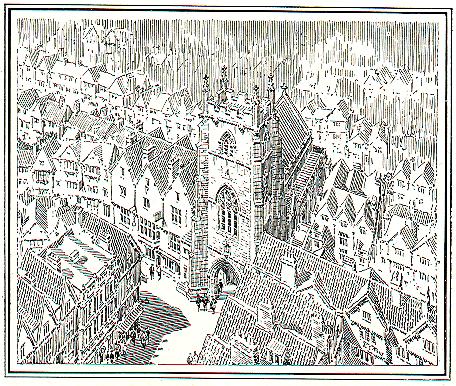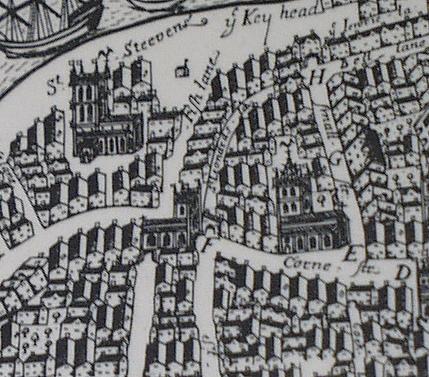
St Leonard
City
BRISTOL
Stood over the Westgate, one of the original entrances to the medieval city, which became known as St Leonard's Gate. This medieval church was one of many in the congested streets of the old city. It stood at the foot of Corn Street, where it is crossed by St Stephen's Street, and fell victim to the improvements being made in this area in the C18 when Baldwin Street was re-routed and Clare Street created. In a Bill presented to Parliament the church was described as "a nuisance" because it blocked the main thoroughfare. The Bill ordering demolition of the church became law in 1765, the parish being united to that of St Nicholas, City, and demolition was done 1770-1. Nothing remains but a small lane is shown on modern maps as Leonard Lane, going from Corn Street to Small Street where in medieval times there was a chapel-of-ease to St Leonard dedicated to St Giles.

The above drawing by A.C. Fare was published in a handbook to St Leonard Redfield in 1948, a mission made possible from monies from the original church vestry to whom the endowments of property in the city centre were entrusted after demolition. Entitled "A bird's eye view of Old St Leonards" it is supposedly based on details from the Millerd Map of Bristol published in 1673. However the map appears to show a church orientated differently to this sketch with a nave and south aisle and a tower placed towards the north-east corner. Certainly old descriptions describe the church as being built out over the gate. This detail is shown below, "F" being St Leonard. (E= St Werburgh, D=All Saints)

The actual map suggests that the west end is built out over Baldwin Street (later St Stephen's Street) which curved around beneath the outside of the medieval city walls with the tower as the Westgate built over the end of Corn Street. There is also a smaller gate leading into St Leonard's Lane (as it is called on this map) which continues southwards as St Nicholas Street which also still exists today.
The vicar of St Leonard also had another important duty in the old city. From 1615 to 1774 the vicar held the office of City Librarian in the original library sited in King Street. The founders and early benefactors gave books and property for a civic library on the understanding that "the vicar of St Leonard's for the time being should have the keeping of the same, if a graduate of the University, and his religion answerable thereto." He was paid two pounds per year and could reside in the building or take the rent.
Page created 19th March 2001